Beko CN 150220 PX, CN 142220 DS User Manual

CN 142220 DS
CN 150220 PX
Refrigerator
Congélateur /réfrigérateur
Kühlschrank/gefrierschrank
Please read this manual first!
Dear Customer,
We hope that your product, which has been produced in modern plants and checked under the most meticulous quality control procedures, will provide you an effective service.
For this, we recommend you to carefully read the entire manual of your product before using it and keep it at hand for future references.
This manual
•Will help you use your appliance in a fast and safe way.
•Read the manual before installing and operating your product.
•Follow the instructions, especially those for safety.
•Keep the manual in an easily accessible place as you may need it later.
•Besides, read also the other documents provided with your product. Please note that this manual may be valid for other models as well.
Symbols and their descriptions
This instruction manual contains the following symbols:
C
A Warning against dangerous conditions for life and property.
B Warning against electric voltage.

CONTENTS
1 Your refrigerator |
3 |
2 Important Safety |
|
Warnings |
4 |
Intended use...................................... |
4 |
For products with a water dispenser;. 6 |
|
Child safety........................................ |
6 |
Compliance with WEEE Directive and |
|
Disposing of the Waste Product: ....... |
6 |
Compliance with RoHS Directive:....... |
6 |
Package information.......................... |
6 |
HCA Warning..................................... |
7 |
Things to be done for energy saving... |
7 |
Recommendations for freshfood |
|
compartment..................................... |
8 |
3 Installation |
9 |
Points to be considered when re- |
|
transporting your refrigerator.............. |
9 |
Before operating your refrigerator....... |
9 |
Disposing of the packaging.............. |
10 |
Disposing of your old refrigerator...... |
10 |
Placing and Installation..................... |
10 |
Changing the illumination lamp ........ |
11 |
Installing the lower ventilation cover.. 11 |
|
Adjusting the feet............................. |
11 |
Changing the door opening direction11. |
|
5 Using your refrigerator 13 |
|
Indicator Panel................................. |
13 |
Door Open Warning......................... |
16 |
Dual cooling system:........................ |
16 |
Freezing fresh food........................... |
16 |
Recommendations for preservation of |
|
frozen food....................................... |
17 |
Placing the food............................... |
17 |
Deep-freeze information................... |
18 |
Movable Body shelf:......................... |
19 |
Odour filter....................................... |
19 |
Rotary storage container.................. |
20 |
Icematic and ice storage container... |
20 |
(in some models).............................. |
20 |
Chill compartment............................ |
21 |
Hygiene - Ion ................................... |
21 |
Water Dispenser............................... |
21 |
*optional........................................... |
21 |
6 Maintenance and |
|
cleaning |
24 |
Protection of plastic surfaces .......... |
24 |
7 Recommended solutions |
|
for the problems |
25 |
4 Preparation |
12 |
2 EN

1 Your refrigerator |
|
|
13 |
|
*14 |
1 |
|
*2 |
|
3 |
*18 |
|
|
*4 |
|
19 |
*15 |
|
16 |
*5 |
|
6 |
|
*7 |
*17 |
|
|
*8 |
|
*9 |
|
10 |
|
20 |
|
10 |
|
10 |
|
11 |
|
12 |
|
1.Fan
2.Ampoule
3.Adjustable body shelves
4.Wine rack
5.0 °C Compartment
6.Crisper cover
7.Salad crisper
8.Icebank
9.Icebank tray
10.Deep-freeze compartment
11.Air grille
12.Adjustable front feet
13.Control panel and temperature control
14.Fridge compartment door shelves
15.Water dispenser
16.Egg holders
17.Bottle shelf
18.Rotary storage container
19.Fridge compartment
20.Freezer compartment
*OPTIONAL
Figures that take place in this instruction manual are schematic and may not correspond exactly with your product. If the subject parts are not included in the product you have purchased, then it is valid for other models.
3 EN

2 Important Safety Warnings
Please review the following information. Failure to observe this information may cause injuries or material damage. Otherwise, all warranty and reliability commitments will become invalid.
The usage life of the unit you purchased is 10 years. This is the period for keeping the spare parts required for the unit to operate as described.
Intended use
This product is intended to be used
•indoors and in closed areas such as homes;
•in closed working environments such as stores and offices;
•in closed accommodation areas such as farm houses, hotels, pensions.
•This product should not be used outdoors.
General safety
•When you want to dispose/scrap the product, we recommend you to consult the authorized service in
order to learn the required information and authorized bodies.
•Consult your authorized service for all your questions and problems related to the refrigerator. Do not intervene or let someone intervene to the refrigerator without notifying the authorised services.
•For products with a freezer compartment; Do not eat cone ice cream and ice cubes immediately after you take them out of the freezer compartment! (This may cause frostbite in your mouth.)
•For products with a freezer compartment; Do not put bottled and canned liquid beverages in the freezer compartment. Otherwise, these may burst.
•Do not touch frozen food by hand; they may stick to your hand.
•Unplug your refrigerator before cleaning or defrosting.
•Vapor and vaporized cleaning materials should never be used in cleaning and defrosting processes of your refrigerator. In such cases, the vapor may get in contact with the electrical parts and cause short circuit or electric shock.
•Never use the parts on your refrigerator such as the door as a means of support or step.
•Do not use electrical devices inside the refrigerator.
•Do not damage the parts, where the refrigerant is circulating, with
drilling or cutting tools. The refrigerant that might blow out when the gas channels of the evaporator, pipe extensions or surface coatings are punctured causes skin irritations and eye injuries.
•Do not cover or block the ventilation holes on your refrigerator with any material.
•Electrical devices must be repaired by only authorised persons. Repairs performed by incompetent persons create a risk for the user.
•In case of any failure or during a maintenance or repair work,
disconnect your refrigerator’s mains supply by either turning off the relevant fuse or unplugging your appliance.
4 EN
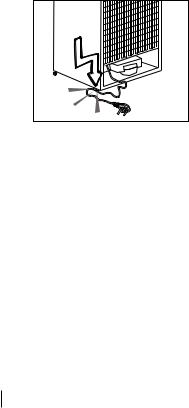
•Do not pull by the cable when pulling off the plug.
•Place the beverage with higher proofs tightly closed and vertically.
•Never store spray cans containing flammable and explosive substances in the refrigerator.
•Do not use mechanical devices or other means to accelerate the
defrosting process, other than those recommended by the manufacturer.
•This product is not intended to be used by persons with physical, sensory or mental disorders or unlearned or inexperienced people (including children) unless they are attended by a person who will be responsible for their safety or who will instruct them accordingly for use of the product
•Do not operate a damaged refrigerator. Consult with the service agent if you have any concerns.
•Electrical safety of your refrigerator shall be guaranteed only if the earth system in your house complies with standards.
•Exposing the product to rain, snow, sun and wind is dangerous with respect to electrical safety.
•Contact authorized service when there is a power cable damage to avoid danger.
•Never plug the refrigerator into the wall outlet during installation. Otherwise, risk of death or serious injury may arise.
•This refrigerator is intended for only storing food items. It must not be used for any other purpose.
•Label of technical specifications is located on the left wall inside the refrigerator.
•Never connect your refrigerator to electricity-saving systems; they may damage the refrigerator.
•If there is a blue light on the refrigerator, do not look at the blue light with optical tools.
•For manually controlled refrigerators, wait for at least 5 minutes to start the refrigerator after power failure.
•This operation manual should be handed in to the new owner of the product when it is given to others.
•Avoid causing damage on power cable when transporting the refrigerator. Bending cable may cause fire. Never place heavy objects on power cable. Do not touch the plug with wet hands when plugging the product.
•Do not plug the refrigerator if the wall outlet is loose.
•Water should not be sprayed directly on inner or outer parts of the product for safety purposes.
•Do not spray substances containing inflammable gases such as propane gas near the refrigerator to avoid fire and explosion risk.
•Never place containers filled with water on top of the refrigerator, otherwise this may cause electric shock or fire.
5 EN

•Do not overload your refrigerator with excessive amounts of food. If overloaded, the food items may fall down and hurt you and damage refrigerator when you open the door. Never place objects on top of the refrigerator; otherwise, these objects may fall down when you open or close the refrigerator's door.
•As they require a precise temperature, vaccines, heat-sensitive medicine and scientific materials and etc. should not be kept in the refrigerator.
•If not to be used for a long time, refrigerator should be unplugged. A possible problem in power cable may cause fire.
•The plug's tip should be regularly cleaned; otherwise, it may cause fire.
•The plug’s tip should be cleaned regularly with a dry cloth; otherwise, it may cause fire.
•Refrigerator may move if adjustable legs are not properly secured on the floor. Properly securing adjustable legs on the floor can prevent the refrigerator to move.
•When carrying the refrigerator, do not hold it from door handle. Otherwise, it may be snapped.
•When you have to place your product next to another refrigerator or freezer, the distance between devices should be at least 8cm. Otherwise, adjacent side walls may be humidified.
For products with a water dispenser;
Pressure of water mains should be minimum 1 bar. Pressure of water mains should be maximum 8 bars.
• Use only potable water.
Child safety
•If the door has a lock, the key should be kept away from reach of children.
•Children must be supervised to prevent them from tampering with the product.
Compliance with WEEE Directive and Disposing of the Waste Product:
This product complies with EU WEEE
Directive (2012/19/EU). This
product bears a classification symbol for
waste electrical and electronic equipment
(WEEE).This product has been manufactured with
high quality parts and materials which can be reused and are suitable for recycling. Do not dispose of the waste product with normal domestic and other wastes at the end of its service life. Take it to the collection center for the recycling of electrical and electronic equipment. Please consult your local authorities to learn about these collection centers.
Compliance with RoHS Directive:
The product you have purchased complies with EU RoHS Directive (2011/65/EU). It does not contain harmful and prohibited materials specified in the Directive.
Package information
Packaging materials of the product are manufactured from recyclable materials in accordance with our National Environment Regulations. Do not dispose of the packaging materials together with the domestic or other wastes. Take them to the packaging material collection points designated by the local authorities.
6 EN

HCA Warning
If your product's cooling system contains R600a:
This gas is flammable. Therefore, pay attention to not damaging the cooling system and piping during usage and transportation. In the event of damage, keep your product away from potential fire sources that can cause the product catch a fire and ventilate the room in which the unit is placed.
Ignore this warning if your product's cooling system contains R134a.
Type of gas used in the product is stated in the type plate which is on the left wall inside the refrigerator.
Never throw the product in fire for disposal.
Things to be done for energy saving
•Do not leave the doors of your refrigerator open for a long time.
•Do not put hot food or drinks in your refrigerator.
•Do not overload your refrigerator so that the air circulation inside of it is not prevented.
•Do not install your refrigerator under direct sunlight or near heat emitting appliances such as ovens, dishwashers or radiators.
•Pay attention to keep your food in closed containers.
•For products with a freezer compartment; You can store maximum amount of food items in the freezer when you remove the shelf or drawer of the freezer. Energy consumption value stated for your refrigerator has been determined
by removing freezer shelf or drawer and under maximum load. There is no harm to use a shelf or drawer
according to the shapes and size of food to be frozen.
•Thawing frozen food in fridge compartment will both provide energy saving and preserve the food quality.
7 EN
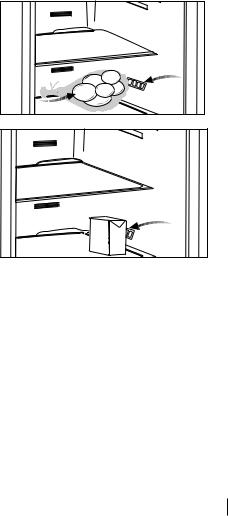
Recommendations for freshfood compartment
* OPTIONAL
•Please do not let any foodstuff to come to contact with the temperature sensor in freshfood compartment.
In order to maintain freshfood compartment at ideal storage temperature, the sensor must not be blocked by fodstuffs.
•Do not place hot foodstuff in your appliance.
food |
temperature |
sensor |
MILK |
temperature |
juice |
|
etc. |
sensor |
|
8 EN
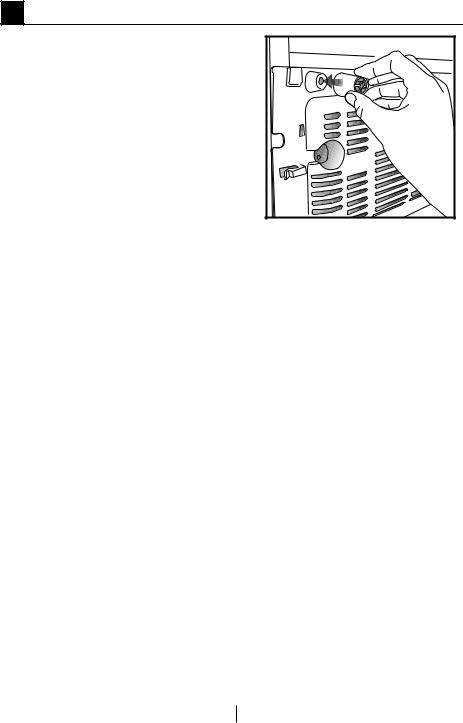
3 Installation
B Please remember that the manufacturer shall not be held liable if the information given in the instruction
manual is not observed.
Points to be considered when re-transporting your refrigerator
1.Your refrigerator must be emptied and cleaned prior to any transportation.
2.Shelves, accessories, crisper and etc. in your refrigerator must be fastened securely by adhesive tape against any jolt before repackaging.
3.Packaging must be tied with thick tapes and strong ropes and the rules of transportation printed on the package must be followed.
Please do not forget…
Every recycled material is an indispensable source for the nature and for our national resources.
If you wish to contribute to recycling the packaging materials, you can get further information from the environmental bodies or local authorities.
Before operating your refrigerator
Before starting to use your refrigerator check the following:
1. Is the interior of the refrigerator dry and can the air circulate freely in the rear of it?
2. Please install the 2 plastic wedges as illustrated in the figure. Plastic wedges will provide the required distance between your refrigerator and the wall in order to allow the air circulation. (The illustrated figure is only an example and does not match
exactly with your product.)
9
3.Clean the interior of the refrigerator as recommended in the “Maintenance and cleaning” section.
4.Plug the refrigerator into the wall outlet. When the fridge door is open, the fridge compartment interior light will come on.
5.You will hear a noise as the compressor starts up. The liquid and gases sealed within the refrigeration system may also give rise to noise, even if the compressor is not running and this is quite normal.
6.Front edges of the refrigerator may feel warm. This is normal. These areas are designed to be warm to
avoid condensation.
Electric connection
Connect your product to a grounded socket which is being protected by a fuse with the appropriate capacity.
Important:
•The connection must be in compliance with national regulations.
•The power cable plug must be easily accessible after installation.
•The specified voltage must be equal to your mains voltage.
EN

•Extension cables and multiway plugs must not be used for connection.
B A damaged power cable must be replaced by a qualified electrician.
B Product must not be operated before it is repaired! There is danger of
electric shock!
Disposing of the packaging
The packing materials may be dangerous for children. Keep the packing materials out of the reach of children or dispose of them by classifying them in accordance with the waste instructions. Do not
dispose of them along with the normal household waste.
The packing of your refrigerator is produced from recyclable materials.
Disposing of your old refrigerator
Dispose of your old refrigerator without giving any harm to the environment.
•You may consult your authorised dealer or waste collection center of your municipality about the disposal of your refrigerator.
Before disposing of your refrigerator, cut out the electric plug and, if there are any locks on the door, make them inoperable in order to protect children against any danger.
Placing and Installation
A If the entrance door of the room where the refrigerator will be installed is not wide enough for the refrigerator to pass through, then call the authorised service to have them remove the doors of your refrigerator and pass it sideways through the door.
1.Install your refrigerator to a place that allows ease of use.
2.Keep your refrigerator away from heat sources, humid places and direct sunlight.
3.There must be appropriate air ventilation around your refrigerator in order to achieve an efficient operation. If the refrigerator is to be placed in a recess in the wall, there must be at least 5 cm distance with the ceiling and at least 5 cm with the wall. If the floor is covered with a carpet, your product must be elevated 2.5 cm from the floor.
4.Place your refrigerator on an even floor surface to prevent jolts.
10 EN
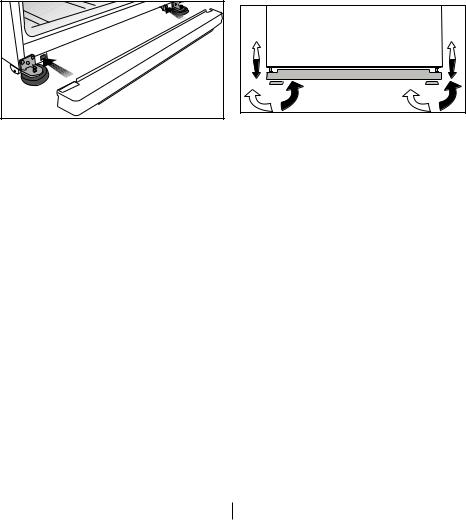
Changing the illumination lamp
To change the lamp used for illumination of your refrigerator, please call your Authorized Service.
Installing the lower ventilation cover
You can install the lower ventilation cover as illustrated in the figure.
Adjusting the feet
If your refrigerator is unbalanced;
You can balance your refrigerator by turning the front legs as shown in the illustration below. The corner where the leg exists is lowered when you turn it in the direction of black arrow and raised when you turn in the opposite direction. Taking help from someone to slightly lift the refrigerator will facilitate this process.
Changing the door opening direction
Door opening direction of your refrigerator can be changed according to the place you are using it. If this is necessary, please call your nearest Authorized Service.
11 EN

4 Preparation
•Your refrigerator should be installed at least 30 cm away from heat sources such as hobs, ovens, central heater and stoves and at least 5 cm away from electrical ovens and should not be located under direct sunlight.
•The ambient temperature of the room where you install your refrigerator should at least be 10°C. Operating your refrigerator under cooler conditions is not recommended with regard to its efficiency.
•Please make sure that the interior of your refrigerator is cleaned thoroughly.
•If two refrigerators are to be installed side by side, there should be at least 2 cm distance between them.
•When you operate your refrigerator for the first time, please observe the following instructions during the initial six hours.
•The door should not be opened frequently.
•It must be operated empty without any food in it.
•Do not unplug your refrigerator. If a power failure occurs out of your control, please see the warnings in
the “Recommended solutions for the problems” section.
•Original packaging and foam materials should be kept for future transportations or moving.
12 EN
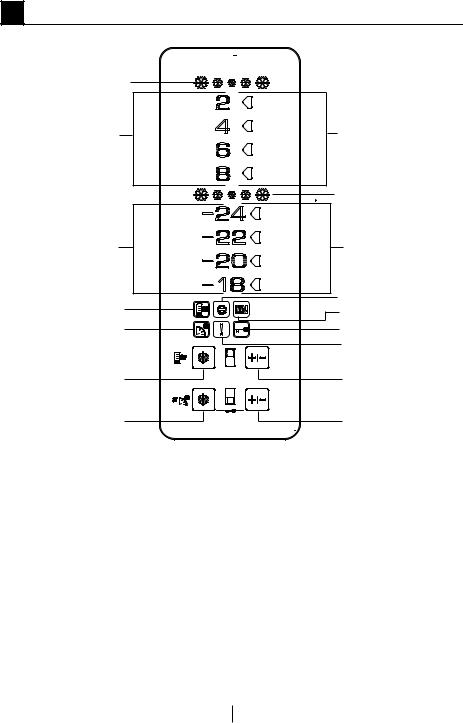
5 Using your refrigerator
10 |
|
8 |
7 |
|
|
|
2 |
5 |
4 |
|
13 |
15 |
14 |
11 |
16 |
|
12 |
9 |
6 |
1 |
3 |
Indicator Panel
1- Quick Freeze Function
Quick Freeze indicator turns on when the Quick Freeze function is on. To cancel this function press Quick Freeze button again. Quick Freeze indicator will turn off and return to its normal settings. If you do not cancel it, Quick Freeze will cancel itself automatically after 4 hours or when the freezer compartment reaches to the required temperature.
If you want to freeze large amounts of fresh food, press the Quick Freeze button before putting the food into the freezer compartment. If you press the Quick Freeze button repeatedly with short intervals, the electronic circuit protection will be activated and the compressor will not start up immediately.
This function is not recalled when power restores after a power failure.
13 EN

2- Quick Freeze Indicator
This icon flashes in an animated style when the Quick Freeze function is active.
3- Freezer Set Function
This function allows you to make the freezer compartment temperature setting. Press this button to set
the temperature of the freezer compartment to -18, -20, -22 and -24 respectively.
4- Freezer Compartment Temperature Setting Indicator
Indicates the temperature set for the Freezer Compartment.
5- Freezer Compartment
Temperature Indicator
-24, -22, -20, -18 indicators light up continuously.
6- Fridge Set Function
This function allows you to make the fridge compartment temperature setting. Press this button to set the
temperature of the fridge compartment to 8, 6, 4, 2 respectively.
7- Fridge Compartment Temperature Setting Indicator
Indicates the temperature set for the Fridge Compartment.
8-Fridge Compartment Temperature Indicator
8, 6, 4 and 2 indicators light up continuously.
9- Quick Fridge Function
When you press Quick Fridge button, the temperature of the compartment will be colder than the adjusted values. This function can be used for food placed in the fridge compartment and required to be cooled down rapidly.
If you want to cool large amounts of fresh food, it is recommended to active this feature before putting the food into the fridge. Quick Fridge indicator will remain lit when the Quick Fridge function is enabled. To cancel this function press Quick Fridge button again. Quick Fridge indicator will turn off and return to its normal settings.
If you do not cancel it, Quick Fridge will cancel itself automatically after 2 hours or when the fridge compartment reaches to the required temperature.
This function is not recalled when power restores after a power failure.
10Quick Fridge Indicator
This icon flashes in an animated style when the Quick Fridge function is active.
11- Eco-Fuzzy (Special Economic Usage) Function
Press the Quick Freeze button for 3 seconds to activate the Eco Fuzzy Function. Refrigerator will start operating in the most economic mode at least 6 hours later and the economic usage indicator will turn on when the function is active. Press the Quick Freeze button for 3 seconds again to deactivate the Eco Fuzzy Function.
14 EN

12High Temperature/ Error Warning Indicator
This light comes on during high temperature failures and error warnings.
13. Economic Usage Indicator
Economic Usage Indicator turns on when the Freezer Compartment is set to -18°C. Economic Usage Indicator turns off when the Quick Fridge or Quick Freeze function is selected.
14Ionizer Indicator Light
Indicator light lights up continuously. This light indicates that your refrigerator is protected against the bacteria.
15-Energy Saving Mode
When you press this button, Energy saving icon will light up and Energy Saving Function will be activated. If energy saving function is active, all icons on the display other than energy saving icon will turn off. When the Energy Saving Function is active, if any button is pressed or the door is opened, Energy Saving Function will be exited and the icons on display will return to normal.If you press this buton again, Energy Saving icon will turn off and Energy Saving Function will not be active.
16-Key Lock Mode
Press Quick Freeze and FRZ Set buttons concurrently for 3 seconds. Key lock icon will light up and key lock mode will be activated. Buttons will not function if the Key Lock mode is active. Press Quick Freeze and FRZ Set buttons concurrently for 3 seconds again. Key lock icon will turn off and the key lock mode will be exited.
15 EN

Door Open Warning |
Freezing fresh food |
A audio warning signal will be given when the fridge compartment door of your product is left open for at least 1 minute. This audio signal will mute when any button on the indicator is pressed or when the door is closed.
Dual cooling system:
Your refrigerator is equipped with two separate cooling systems to cool the fresh food compartment and freezer compartment. Thus, air in the fresh food compartment and freezer compartment do not get mixed. Thanks to these two separate cooling
systems, cooling speed is much higher then other refrigerators. Odors in the compartments do not get mixed. Also additional power saving is provided since the defrosting is performed individually.
•It must be preferred to wrap or cover the food before placing them in the refrigerator.
•Hot food must cool down to the room temperature before putting them in the refrigerator.
•The foodstuff that you want to freeze must be fresh and in good quality.
•Foodstuff must be divided into portions according to the family’s daily or meal based consumption needs.
•The foodstuff must be packaged in an airtight manner to prevent them from drying even if they are going to be kept for a short time.
•Materials to be used for packaging must be tear-proof and resistant to cold, humidity, odor, oils and acids and they must also be airtight.
Moreover, they must be well closed and they must be made from easy- to-use materials that are suitable for deep freeze usage.
Freezer Compartment |
Fridge |
|
|
Compartment |
Explanations |
||
Adjustment |
|||
Adjustment |
|
||
|
|
||
|
|
|
|
-18°C |
4°C |
This is the normal recommended setting. |
|
|
|
|
|
-20,-22 or -24°C |
4°C |
These settings are recommended when the ambient |
|
temperature exceeds 30°C. |
|||
|
|
||
|
|
|
|
Quick Freeze |
|
Use when you wish to freeze your food in a short time. |
|
4°C |
Your refrigerator will return to its previous mode when |
||
|
|||
|
|
the process is over. |
|
|
|
|
|
|
|
If you think that your fridge compartment is not cold |
|
-18°C or colder |
2°C |
enough because of the hot conditions or frequent |
|
|
|
opening and closing of the door. |
|
|
|
|
|
|
|
You can use it when your fridge compartment is |
|
-18°C or colder |
Quick Fridge |
overloaded or if you wish to cool down your food |
|
|
rapidly. It is recommended that you activate quick |
||
|
|
||
|
|
fridge function 4-8 hours before placing the food. |
16 EN

•Food to be frozen must be put in the freezer compartment. (They should not be allowed to come in contact with the previously frozen items to prevent their partial thawing. Freezing capacity of our product is given in the technical specifications of your refrigerator.)
•Periods given in the information about deep freeze must be obeyed for storage times.
•Frozen food must be used immediately after they are thawed and they should never be re-frozen.
•Please observe the following instructions to obtain the best results.
1.Do not freeze too large quantities of food at one time. The quality of the food is best preserved when it is frozen right through to the core as quickly as possible.
2.Placing warm food into the freezer compartment causes the cooling system to operate continuously until the food is frozen solid.
3.Take special care not to mix already frozen food and fresh food.
Recommendations for preservation of frozen food
•Prepacked commercially frozen food should be stored in accordance with the frozen food manufacturer’s instructions for a  ( 4 star) frozen food storage compartment.
( 4 star) frozen food storage compartment.
•To ensure that the high quality achieved by the frozen food manufacturer and the food retailer is maintained, the following should be
remembered:
1.Put packages in the freezer as quickly as possible after purchase.
2.Ensure that contents are labeled and dated.
3.Do not exceed “Use By”, “Best Before” dates on the packaging.
If there is a power failure do not open the freezer door. Even if the power failure lasts up to the “Temperature Increasing Time” indicated in the “Technical specifications of your refrigerator” section, frozen food will not be affected. In case the failure lasts longer, the food must be checked and when necessary, must be consumed immediately or must be frozen after cooked.
Defrosting
The freezer compartment defrosts automatically.
Placing the food
|
|
|
Freezer |
Various frozen food |
|
such as meat, fish, |
||
compartment |
||
ice cream, vegetables |
||
shelves |
||
and etc. |
||
|
||
Egg holder |
Egg |
|
|
|
|
Fridge |
Food in pans, covered |
|
compartment |
plates and closed |
|
shelves |
containers |
|
|
|
|
Fridge |
Small and packaged |
|
food or drinks (such |
||
compartment door |
||
as milk, fruit juice and |
||
shelves |
||
beer) |
||
|
||
|
|
|
Crisper |
Vegetables and fruits |
|
|
|
|
Freshzone |
Delicatessen products |
|
(cheese, butter, salami |
||
compartment |
||
and etc.) |
||
|
||
|
|
17 EN

Deep-freeze information
Food must be frozen as rapidly as possible when they are put in a refrigerator in order to keep them in good quality.
The TSE norm requires (according to certain measurement conditions) the refrigerator to freeze at least 4.5 kg of foodstuff at 32°C ambient temperature to -18°C or lower within 24 hours for every 100-liters of freezer volume.
It is possible to keep the food for a long time only at -18°C or lower temperatures.
You can keep the freshness of food for many months (at -18°C or lower temperatures in the deep freeze).
WARNING! A
•Foodstuff must be divided into portions according to the family’s daily or meal based consumption needs.
•Foodstuff must be packaged in an airtight manner to prevent them from drying even if they are going to be kept for a short time.
Materials necessary for packaging:
•Cold resistant adhesive tape
•Self adhesive label
•Rubber rings
•Pen
Materials to be used for packaging the foodstuff must be tear-proof and resistant to cold, humidity, odor, oils and acids.
Foodstuff to be frozen should not be allowed to come in contact with the previously frozen items to prevent their partial thawing.
Always follow the values in the tables for storage periods.
Frozen food must be used immediately after they are thawed and they should never be re-frozen.
18 EN
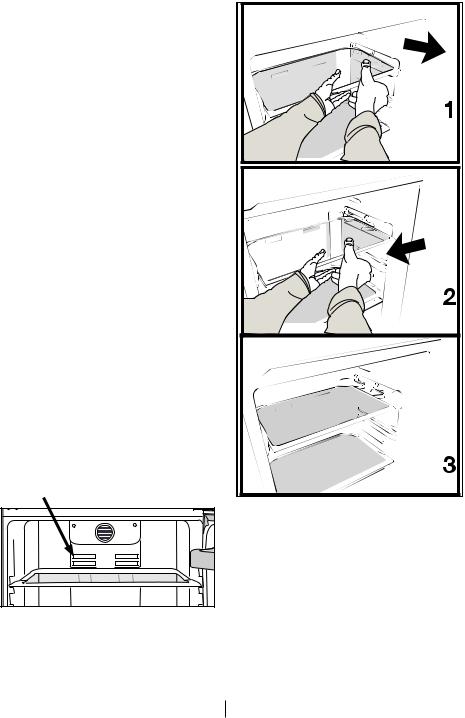
Movable Body shelf:
When you need to expand the distance between two shelves, movable body shelf allows you to move glass shelf up and down
without removing it. To move down the body shelf, pull it towards yourself in a balanced way by holding with both hands (1); when the glass shelf reaches the frontmost position, it will move downwards by means of inclined surface (2). To move the shelf to an upper position, again by holding with both hands in a balanced way, move
it upwards on the inclined surface and push the glass shelf to insert it into the housing at the end of inclined surface. Make sure that movable body shelf is always parallel to the ground; otherwise materials on the shelf might fall down. When you need to move the body shelf up or down, remove the items on the shelf.
Odour filter
* OPTIONAL
Odour filter in the air duct of the fridge compartment prevents the build-up of unpleasant odours in the refrigerator.
19 EN
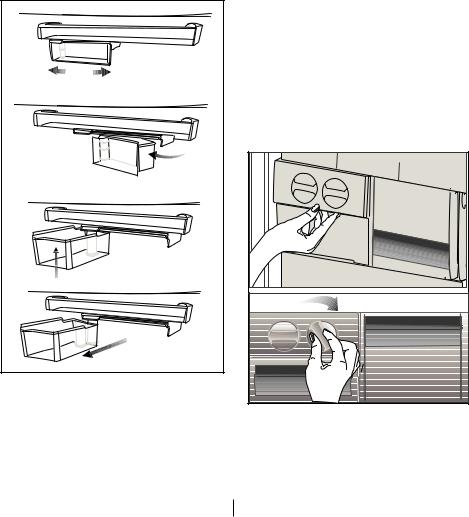
Rotary storage container
Sliding body shelf can be moved to left or right in order to allow you place long bottles, jars or boxes to a lower shelf (Fig. 1)
You can reach the food that you have placed into the shelf by grabbing and turning it from its right edge (Fig.2).
When you want to load or remove it to clean, turn it by 90 degrees, raise it up and pull towards yourself (Fig. 3-4).
1 |
2 |
3 |
4 |
Icematic and ice storage container
(in some models) Using the Icematic
Fill the Icematic with water and place it into its seat. Your ice will be ready approximately in two hours. Do not remove the Icematic from its seating to take ice.
Turn the knobs on it clockwise by 90 degrees.
Ice cubes in the cells will fall down into the ice storage container below.
You may take out the ice storage container and serve the ice cubes.
If you wish, you may keep the ice cubes in the ice storage container.
Ice storage container
Ice storage container is only intended for accumulating the ice cubes. Do not put water in it. Otherwise, it will break.
20 EN

Chill compartment
You can increase the inner volume of your refrigerator by removing the desired snack compartment. Pull the compartment towards yourself until it is stopped by the stopper. Raise the front part for approximately 1 cm and
pull the compartment towards yourself again to remove it completely.
You can place the food that you want to freeze in order to prepare them for freezing in these compartments. You can also use these compartments
if you want to store your food at a temperature a few degrees below the fridge compartment.
Hygiene - Ion
Hygiene+: The photocatalyst filter in the air channel of refrigerator helps to clean the air inside. Also this filter reduces bad smells.
Ion+: Ionizer, that is in the air channel of refrigerator, ionizers the air. With the help of this system airborne bacteria and bad smells originated from these bacteria will be reduced.
Water Dispenser
*optional
Water dispenser is a very useful feature based on reaching cold water without opening the door of your refrigerator. As you will not have to open your refrigerator door frequently, you will have saved energy.
Using the water dispenser
Push the arm of the water dispenser with your glass. The dispenser will cease operating once you release the arm.
When operating the water dispenser, maximum flow can be obtained
by pressing the arm fully. Please remember that the amount of flow from the dispenser is subject to the degree you press the arm.
21 EN
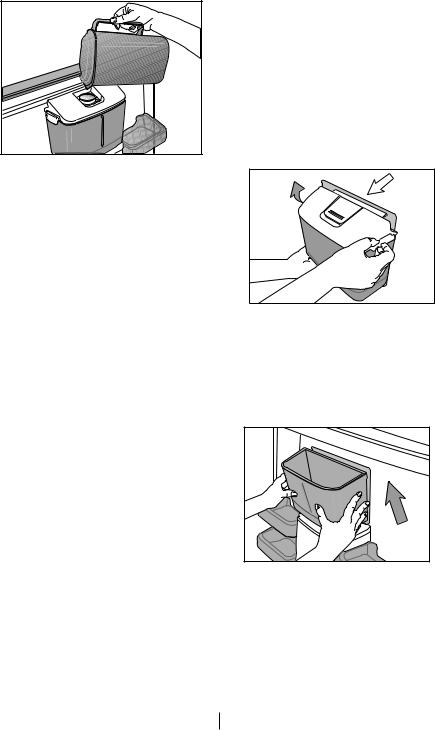
As the level of the water in your glass/ container rises, slightly lessen the pressure on the arm to prevent the overspill. If you slightly press the arm, the water will drip; this is quite normal and not a failure.
Filling the water dispenser's tank
Open the cover of the water tank as shown in the figure. Fill in the pure and clean drinking water. Close the cover.
To avoid flowing of water by mistake, we recommend you to lock the water dispenser .
Warning!
•Do not fill the water tank with any other liquid except for water such as fruit juices, carbonated beverages or alcoholic drinks which are not
suitable to use in the water dispenser. Water dispenser will be irreparably damaged if these kinds of liquids are used. Warranty does not cover such usages. Some chemical substances and additives contained in these kinds of drinks/liquids may damage the water tank.
•Use clean and pure drinking water only.
•Capacity of the water tank is 2.2 liters (3.8 pints); do not overfill.
•Push the arm of the water dispenser with a rigid glass. If you are using disposable plastic glasses, push the arm with your fingers from behind the glass.
1  2
2
 1
1
Cleaning the water tank
Release the tank cover from the water tank by opening latches at both sides. Remove the water tank and clean with warm and clean water. Place the water tank to its seating, install the tank cover and close the latches.
3 |
22 EN

Water tray
Water that dripped while using the water dispenser accumulates in the spillage tray. Take out the spillage tray by pulling it towards yourself and empty it regularly.
Take out the plastic strainer by pressing it on sides.
Take the water valve out of the water tank. When replacing it, make sure that the seal is in place.
Make sure that the parts removed (if any) during cleaning are properly attached to their original places.
Otherwise, water leakage may occur.
Important:
Components of the water tank and water dispenser should not be washed in dishwasher.
23 EN

6 Maintenance and cleaning
A Never use gasoline, benzene or similar substances for cleaning purposes.
B We recommend that you unplug the appliance before cleaning.
B Never use any sharp abrasive instrument, soap, household cleaner, detergent and wax polish for cleaning.
CUse lukewarm water to clean the cabinet of your refrigerator and wipe it dry.
CUse a damp cloth wrung out in a solution of one teaspoon of
bicarbonate of soda to one pint of water to clean the interior and wipe it dry.
B Make sure that no water enters the lamp housing and other electrical items.
B If your refrigerator is not going to be used for a long period of time, unplug the power cable, remove all food, clean it and leave the door ajar.
CCheck door seals regularly to ensure they are clean and free from food particles.
A To remove door racks, remove all the contents and then simply push the door rack upwards from the base.
ANever use cleaning agents or water that contain chlorine to clean the outer surfaces and chromium coated parts of the product. Chlorine causes
corrosion on such metal surfaces.
Protection of plastic surfaces
CDo not put the liquid oils or oil-cooked meals in your refrigerator in unsealed containers as they damage the plastic surfaces of your refrigerator. In case of spilling or smearing oil on the plastic surfaces, clean and rinse the relevant part of the surface at once with warm water.
24 EN
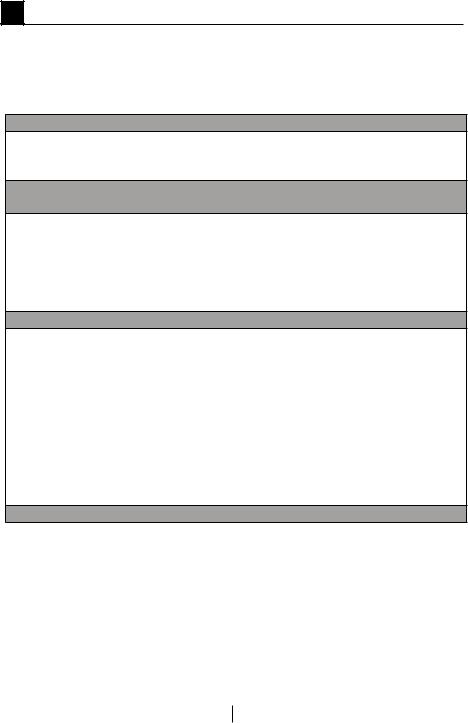
7 Recommended solutions for the problems
Please review this list before calling the service. It might save you time and money. This list includes frequent complaints that are not arising from defective workmanship or material usage. Some of the features described here may not exist in your product.
The refrigerator does not operate.
•Is the refrigerator properly plugged in? Insert the plug to the wall socket.
•Is the fuse of the socket which your refrigerator is connected to or the main fuse blown out? Check the fuse.
Condensation on the side wall of the fridge compartment (MULTIZONE, COOL CONTROL and FLEXI ZONE).
•Very cold ambient conditions. Frequent opening and closing of the door. Highly humid ambient conditions. Storage of food containing liquid in open containers. Leaving the door ajar. Switching the thermostat to a colder degree.
•Decreasing the time the door left open or using it less frequently.
•Covering the food stored in open containers with a suitable material.
•Wipe the condensation using a dry cloth and check if it persists.
Compressor is not running
•Protective thermic of the compressor will blow out during sudden power failures or plug-out plug-ins as the refrigerant pressure in the cooling system of the refrigerator has not been balanced yet. Your refrigerator will start running approximately after 6 minutes. Please call the service if the refrigerator does not startup at the end of this period.
•The fridge is in defrost cycle. This is normal for a full-automatically defrosting refrigerator. Defrosting cycle occurs periodically.
•Your refrigerator is not plugged into the socket. Make sure that the plug is properly fit into the socket.
•Are the temperature adjustments correctly made?
•Power might be cut off.
The fridge is running frequently or for a long time.
25 EN
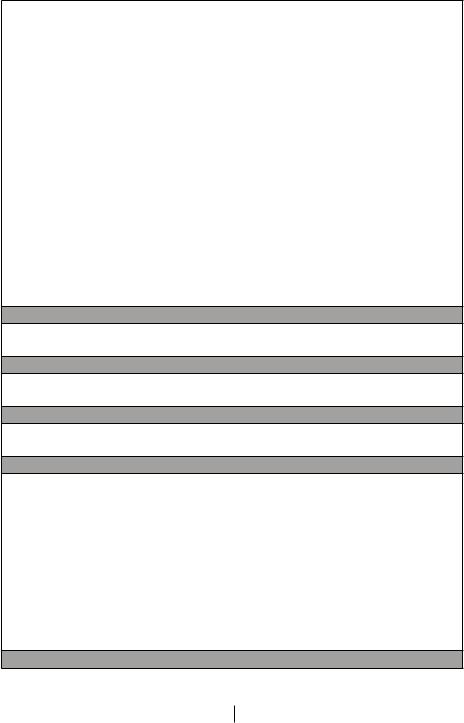
•Your new product may be wider than the previous one. This is quite normal.
Large refrigerators operate for a longer period of time.
•The ambient room temperature may be high. This is quite normal.
•The refrigerator might have been plugged in recently or might have been loaded with food. Cooling down of the refrigerator completely may last for a couple of hours longer.
•Large amounts of hot food might have been put in the refrigerator recently. Hot food causes longer running of the refrigerator until they reach the safe storage temperature.
•Doors might have been opened frequently or left ajar for a long time. The warm air that has entered into the refrigerator causes the refrigerator to run for longer periods. Open the doors less frequently.
•Freezer or fridge compartment door might have been left ajar. Check if the doors are tightly closed.
•The refrigerator is adjusted to a very low temperature. Adjust the refrigerator temperature to a warmer degree and wait until the temperature is achieved.
•Door seal of the fridge or freezer may be soiled, worn out, broken or not properly seated. Clean or replace the seal. Damaged/broken seal causes the refrigerator to run for a longer period of time in order to maintain the current temperature.
Freezer temperature is very low while the fridge temperature is sufficient.
•The freezer temperature is adjusted to a very low temperature. Adjust the freezer temperature to a warmer degree and check.
Fridge temperature is very low while the freezer temperature is sufficient.
•The fridge temperature might have been adjusted to a very low temperature.
Adjust the fridge temperature to a warmer degree and check.
Food kept in the fridge compartment drawers are freezing.
•The fridge temperature might have been adjusted to a very low temperature.
Adjust the fridge temperature to a warmer degree and check.
Temperature in the fridge or freezer is very high.
•The fridge temperature might have been adjusted to a very high degree.
Fridge adjustment has an effect on the temperature of the freezer. Change the temperature of the fridge or freezer until the fridge or freezer temperature reaches to a sufficient level.
•Doors might have been opened frequently or left ajar for a long time; open them less frequently.
•Door might have been left ajar; close the door completely.
•Large amount of hot food might have been put in the refrigerator recently. Wait until the fridge or freezer reaches the desired temperature.
•The refrigerator might have been plugged in recently. Cooling down of the refrigerator completely takes time.
The operation noise increases when the refrigerator is running.
26 EN
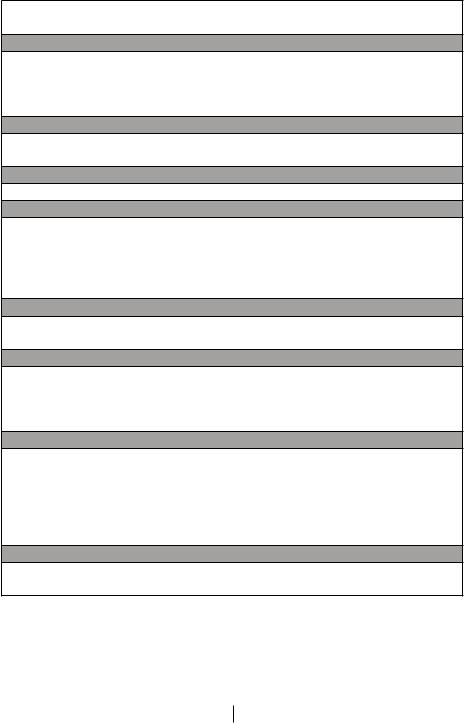
•The operating performance of the refrigerator may change due to the changes in the ambient temperature. It is normal and not a fault.
Vibrations or noise.
•The floor is not even or it is weak. The refrigerator rocks when moved slowly.
Make sure that the floor is strong enough to carry the refrigerator, and level.
•The noise may be caused by the items put onto the refrigerator. Items on top of the refrigerator should be removed.
There are noises coming from the refrigerator like liquid spilling or spraying.
•Liquid and gas flows happen in accordance with the operating principles of your refrigerator. It is normal and not a fault.
There is a noise like wind blowing.
•Fans are used in order to cool the refrigerator. It is normal and not a fault.
Condensation on the inner walls of refrigerator.
•Hot and humid weather increases icing and condensation. It is normal and not a fault.
•Doors might have been left ajar; make sure that the doors are closed fully.
•Doors might have been opened frequently or left ajar for a long time; open them less frequently.
Humidity occurs on the outside of the refrigerator or between the doors.
•There might be humidity in the air; this is quite normal in humid weather. When the humidity is less, condensation will disappear.
Bad odour inside the refrigerator.
•Inside of the refrigerator must be cleaned. Clean the inside of the refrigerator with a sponge, lukewarm water or carbonated water.
•Some containers or package materials might cause the smell. Use a different container or different brand packaging material.
The door is not closing.
•Food packages may prevent the door's closing. Replace the packages that are obstructing the door.
•The refrigerator is not completely upright on the floor and rocking when slightly moved. Adjust the elevation screws.
•The floor is not level or strong. Make sure that the floor is level and capable to carry the refrigerator.
Crispers are stuck.
•The food might be touching the ceiling of the drawer. Rearrange food in the drawer.
27 EN
Veuillez commencer par lire ce manuel:
Cher client,
Nous espérons que vous serez satisfait de ce produit fabriqué dans une usine de pointe. Cet appareil a subi des contrôles de qualité très méticuleux.
Veuillez donc lire l’ensemble de la notice avant d’utiliser votre appareil. N’oubliez pas de donner ce manuel si vous cédez le produit à quelqu’un.
Ce manuel:
•vous aidera à utiliser votre produit avec rapidité et sécurité.
•Lisez le manuel avant d’installer et de faire fonctionner votre produit.
•Respectez les instructions, notamment celles relatives à la sécurité.
•Conservez ce manuel dans un endroit facile d’accès car vous pouvez en avoir besoin ultérieurement.
•En plus, lisez également les autres documents fournis avec votre produit.
•Veuillez noter que ce manuel peut également être valide pour d’autres modèles.
Symboles et descriptions
Vous retrouverez les symboles suivants dans le présent manuel :
C Informations importantes ou astuces.
AAvertissement relatif aux situations dangereuses en matière de sécurité des personnes et des biens.
BAvertissement en cas de risque de décharge électrique.

Table des matières
1 Votre Congélateur / |
|
|
réfrigérateur |
3 |
|
2 |
Précautions importantes |
|
pour votre sécurité |
4 |
|
Utilisation prévue................................ |
4 |
|
Pour les appareils dotés d'une fontaine |
||
à eau ;................................................ |
6 |
|
Sécurité enfants................................. |
6 |
|
Conformité avec la directive DEEE et |
||
mise au rebut des déchets :............... |
6 |
|
Conformité avec la directive LdSD : .. 7 |
||
Informations relatives à l'emballage.... |
7 |
|
Avertissement HCA............................ |
7 |
|
Mesures d’économie d’énergie.......... |
7 |
|
Recommandations pour le |
|
|
compartiment produits frais................ |
8 |
|
3 |
Installation |
9 |
Points à prendre en compte lorsque |
|
|
vous transportez à nouveau votre |
|
|
produit............................................... |
9 |
|
Avant de faire fonctionner votre |
|
|
Congélateur / réfrigérateur.................. |
9 |
|
Branchement électrique..................... |
9 |
|
Remplacement de la lampe ............. |
10 |
|
Installation du cache de ventilation |
|
|
inférieur............................................ |
10 |
|
Inversion de la direction de l’ouverture |
||
de la porte........................................ |
10 |
|
Réglage des pieds........................... |
10 |
|
Mise au rebut de l’emballage............ |
10 |
|
Mise au rebut de votre ancien |
|
|
Congélateur / réfrigérateur................ |
10 |
|
4 |
Préparation |
11 |
5 |
Utilisation du réfrigérateur |
|
/congelateur |
12 |
|
Bandeau indicateur.......................... |
12 |
|
Avertissement - Porte ouverte.......... |
15 |
|
Système de réfrigération Dual :......... |
15 |
|
Congélation des produits frais.......... |
15 |
|
Recommandations concernant la |
|
|
conservation des aliments congelés.16 |
||
Disposition des denrées................... |
16 |
|
Informations concernant la |
|
|
congélation...................................... |
17 |
|
Etagère amovible:............................. |
18 |
|
Filtre à odeurs.................................. |
18 |
|
Récipient de conservation rotatif...... |
19 |
|
Distributeur et récipient de |
|
|
conservation de glaçons.................. |
19 |
|
Compartiment Fraîcheur................... |
20 |
|
Fontaine frigorifique.......................... |
20 |
|
6 Entretien et nettoyage |
23 |
|
Protection des surfaces en |
|
|
plastique. ........................................ |
23 |
|
7 Dépannage |
24 |
|
2 FR
